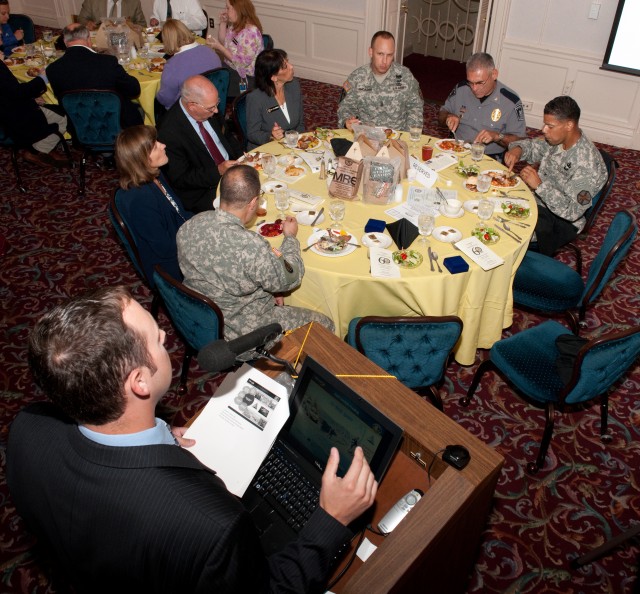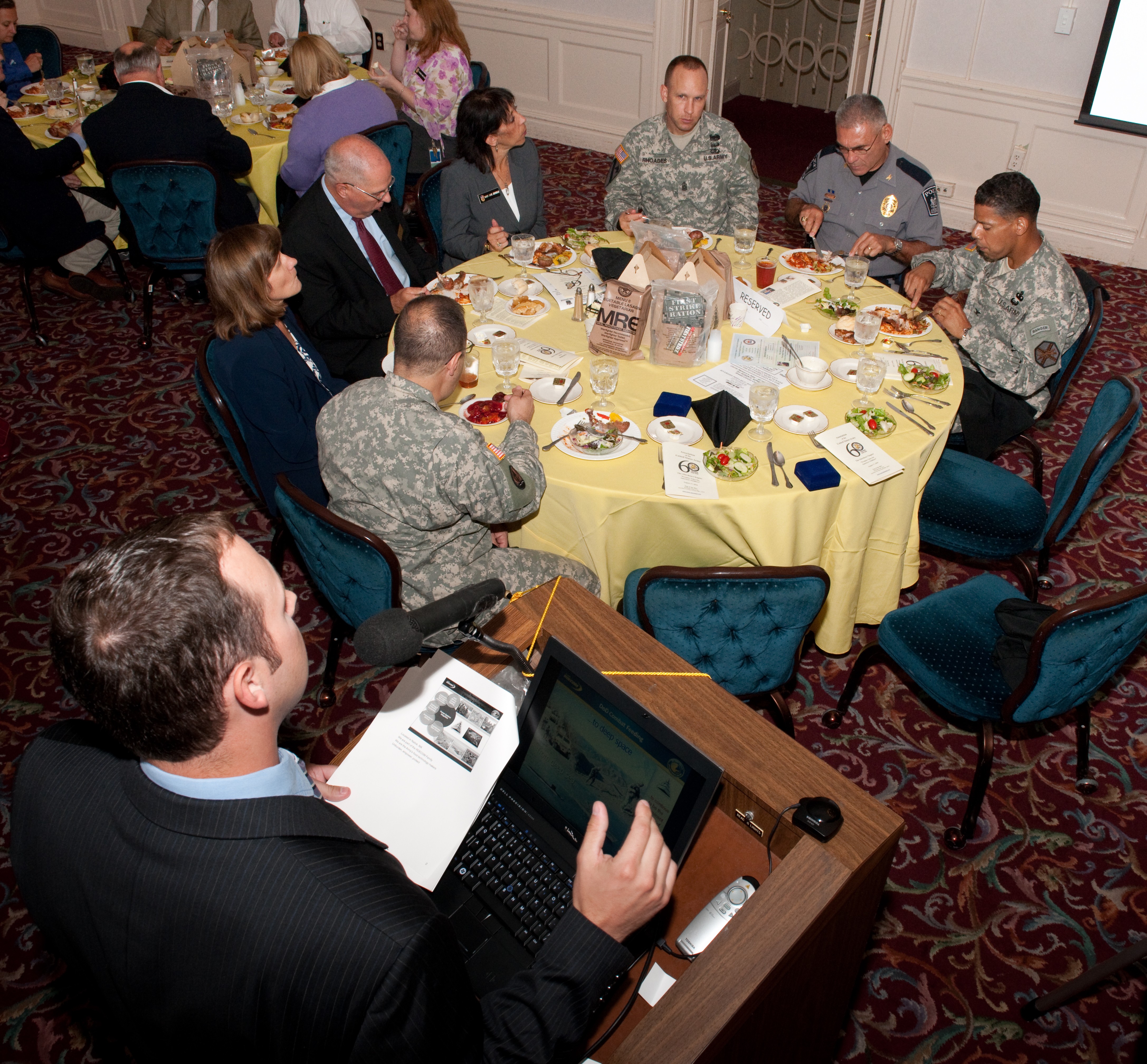
ABERDEEN PROVING GROUND, Md. -- Meeting the nutritional needs and taste preferences of 1.9 million Warfighters every day is vital to America's success in battlefield missions, combat feeding officials said.
"The most important thing on the battlefield is to unburden, empower and protect the Soldiers," said Jeremy Whitsitt, program outreach and education coordinator for the Department of Defense Combat Feeding Directorate at Natick Soldier Research, Development and Engineering Center.
CFD personnel are continually trying to improve field rations to please their customers - Warfighters.
"Our customers carry weapons, so we don't want to antagonize them," Whitsitt said jokingly to a group of about 80 Soldiers and civilians. Whitsitt and Evan Bick, assistant program outreach and education coordinator for CFD, spoke Aug. 17 at the Association of the U.S. Army-Aberdeen Chapter luncheon at Top of the Bay.
Whitsitt recited the event that drove major changes to combat feeding. On a late Friday afternoon in 1991, Gen. Colin Powell called high-ranking CFD officials in Natick, Mass., to the Pentagon for an urgent meeting. When they arrived, Powell held up a Meal Ready-to-Eat and said, "See this' Fix it."
Whitsitt said that negative feedback from Soldiers during Desert Shield and Desert Storm prompted the start of the MRE continuous improvement program. CFD increased MRE menus from 12 to 24 and worked to improve nutrition, variety and taste. Troops must rate rations with a six or higher on a scale of one to nine in order to be fielded.
"Our products are tested and approved by Warfighters," he said.
Bick detailed the process that CFD scientists and researchers use to meet the demands of Warfighters on the battlefield.
"We simultaneously work in what is being demanded by the Warfighter - what they want to see in their meal package," Bick said. "Our food scientists, chemists and biologists are working on the cutting edge of food science to see what we can deliver. We want to incorporate Warfighter input into everything that we do. Nothing gets fielded until it's been approved in actual field testing by Soldiers, Sailors, Airmen and Marines."
The next field test will be in September at Marine Air Ground Task Force Training Command in Twentynine Palms, Calif.
Whitsitt and Bick brought combat rations for the audience to sample. The MRE menu included chili with beans, boneless pork rib, beef ravioli in meat sauce, maple sausage, chicken with tomato and feta, meatballs with marinara and vegetable lasagna.
In addition to taste, providing proper nutrition to Soldiers in combat situations is a major challenge, Whitsitt said. Food scientists, nutritionists, dieticians and microbiologists work to ensure the correct balance of protein, carbohydrates, fat and vitamins are available in meals to optimize Soldier performance.
"If the nutrition isn't there, it's not doing anybody any good," Whitsitt said.
Rations must also be easy to transport and carry, especially when Warfighters are faced with rugged terrain in the remote areas of Iraq and Afghanistan, Bick said. To alleviate this obstacle, CFD introduced the First Strike Ration in 2008.
"Are they easy to eat' Are they easy to carry'" he said.
The FSRs allow Warfighters to eat on the move, and they provide energy when needed. They are also lighter and take up less space. Audience members tried chicken, tuna, and pepperoni FSRs, as well as energy bars, caffeine gum, pocket sandwiches and carbohydrate energy gels.
"We lighten the load," Whitsitt said. "We provide high-calorie items that will sustain them on the battlefield but in less packaging and less volume to allow them to complete their mission more effectively and efficiently."
CFD is working on solutions to the unique battlefield challenges presented in Operating Iraqi Freedom and Operation Enduring Freedom. Bick addressed the logistical challenges of feeding troops in today's conflicts.
"One of the big problems we are facing in the current operating environment is Soldiers trying to execute counter-insurgency," he said. "They are breaking down into smaller, more remote bases.
How can we get the hot food that is a morale booster to the troops' The First Strike Ration is a much lighter product that contains enough calories for a day that enables a Soldier to operate in a high-intensity conflict."
Keeping combat troops safe is no longer just the domain of scientists who develop the latest armor, tanks, trucks and aircraft. CFD personnel utilize the latest food technology to improve Warfighters' safety by reducing their exposure to the enemy, Bick said.
"We've also developed a Unified Group Ration-Express that we call a kitchen in a carton," he said. "It's one box about 2 feet by 2 feet by 2 feet that contains everything you need to provide 18 Soldiers with a hot meal. Pull the tab, it heats itself up, and 35 minutes later, you have a hot meal to increase morale without putting Soldiers at risk in terms of running convoys to get hot food to more remote operating bases."

Social Sharing